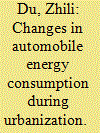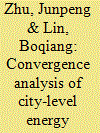| Srl | Item |
| 1 |
ID:
166965


|
|
|
|
|
| Summary/Abstract |
Automobile sector is one of the important parts of the transportation industry. China's booming auto sector has also brought huge energy consumption, and energy consumption in the automobile sector will continue to increase with the further development of China's economy. Urbanization is a complex process of modernization, and it may be an important reason for the change in automobile energy consumption. According to the current literature, the impact of urbanization may exist as a positive or negative mechanism. Based on the sample of 279 cities in 31 provinces of China from 2003 to 2015, this paper analyzes how urbanization affects automobile energy consumption in the disparity of income, and then it also further explores the heterogeneity of automobile energy consumption in different regions. The conclusion of this paper shows that considering the income disparity, the effect of urbanization on automobile energy consumption increased first and then decreased. The regions with relatively low automobile energy consumption will gradually catch up with the high energy consumption regions, and automobile energy consumption in each region will not converge to its own steady state.
|
|
|
|
|
|
|
|
|
|
|
|
|
|
|
|
| 2 |
ID:
176686


|
|
|
|
|
| Summary/Abstract |
Understanding the convergence patterns of energy intensity and the drivers leading to the club convergence are of great significance for local governments to implement targeted policies to improve energy efficiency. With this in mind, we begin with the collection of energy consumption data of 193 Chinese cities at prefecture level or above, then we adopt the log t-test and clustering algorithm to investigate convergence characteristics of energy intensity. Besides, the Ordered Probit model is adopted to investigate the drivers that affect the formulation of convergent club. We identify four convergent clubs among total 193 cities, and these clubs show great differences in energy intensity. Marketization degree, population density, foreign direct investment, resource endowment, and industrial structure are recognized as the drivers of the formation of convergence clubs. This paper adds more evidence to understand the energy intensity gap, we propose that upgrading the industrial structure, exerting economic assemble advantage, enhancing the level of opening up, and improving the marketization level are favorable measures to reduce energy intensity.
|
|
|
|
|
|
|
|
|
|
|
|
|
|
|
|